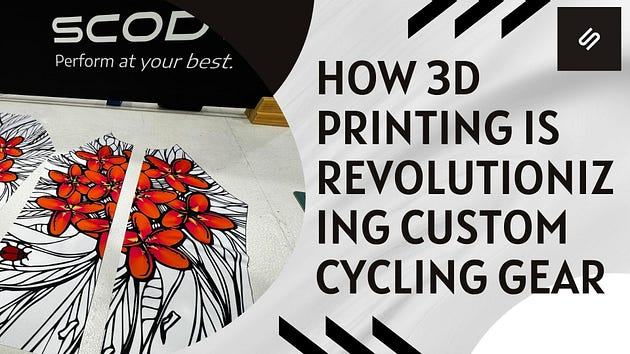How 3D Printing is Revolutionizing Custom Cycling Gear

The world of cycling is constantly evolving, and innovation in gear plays a crucial role in enhancing performance, comfort, and aesthetics. One of the most groundbreaking advancements in recent years is 3D printing — a technology that is reshaping the way custom cycling clothing and gear are designed, manufactured, and personalized.
From aerodynamic helmets to tailor-made cycling shoes and even 3D-printed fabrics, this technology is unlocking new possibilities for cyclists who seek the perfect blend of function and style. In this article, we explore how 3D printing is transforming the cycling industry and how it benefits cyclists at all levels.
1. What is 3D Printing in Cycling Gear?
3D printing, also known as additive manufacturing, is a process that builds objects layer by layer using digital models. Unlike traditional manufacturing, which relies on cutting and molding materials, 3D printing allows for greater precision, reduced waste, and highly customized designs.
For cyclists, this means gear that is not only lighter and more aerodynamic but also perfectly tailored to individual body shapes and riding preferences. The ability to create custom cycling clothing and accessories with enhanced performance features is revolutionizing the way riders interact with their equipment.
2. Custom Cycling Clothing: The Future of Personalized Fit
Cyclists know the importance of a well-fitted jersey or bib shorts. A slight misfit can cause discomfort, chafing, or drag, affecting performance on long rides. Traditionally, custom cycling clothing relied on manual measurements and standard fabric manufacturing processes. However, with 3D body scanning and printing, companies can now produce cycling apparel with an unparalleled level of precision.
How It Works:
- 3D Body Scanning: Cyclists can get scanned to create a precise digital model of their body shape.
- Customized Fabrication: Based on the scan, custom cycling clothing can be tailored to each rider’s exact dimensions.
- Enhanced Material Structures: 3D printing enables the creation of seamless, lightweight, and highly breathable materials that improve aerodynamics and moisture control.
With these advancements, cyclists no longer have to compromise between comfort and performance — they can have gear that fits like a second skin.
3. Aerodynamics and Performance Enhancement

In competitive cycling, every millisecond counts. 3D printing allows for the creation of aerodynamic cycling gear that minimizes wind resistance and maximizes speed. Engineers use computational fluid dynamics (CFD) to design jerseys, skinsuits, and even helmets that improve airflow and reduce drag.
Key Benefits:
- Textured Surface Designs: Similar to how golf balls reduce drag, 3D-printed cycling apparel can feature microscopic textures that optimize airflow.
- Integrated Ventilation Systems: Instead of adding separate ventilation panels, 3D printing allows for built-in airflow channels that enhance cooling.
- Optimized Padding: Traditional cycling shorts rely on foam padding, but 3D printing enables custom-shaped chamois padding that matches the rider’s anatomy perfectly.
For both professional athletes and recreational cyclists, these advancements mean better endurance, reduced fatigue, and improved overall riding experience.
4. 3D-Printed Cycling Shoes: A New Level of Customization
Foot comfort is critical in cycling, and custom 3D-printed cycling shoes are making waves in the industry. Unlike mass-produced shoes that may not fit every foot shape, 3D printing allows for precise, foot-specific designs that offer superior support, power transfer, and comfort.
Advantages of 3D-Printed Cycling Shoes:
- Perfect Fit: Designed to match individual foot contours, reducing pressure points.
- Lightweight & Rigid: Provides better power transfer for efficient pedaling.
- Sustainability: Reduces material waste by printing only what’s needed.
Cyclists who invest in custom cycling clothing should consider pairing it with 3D-printed shoes for a fully optimized riding experience.
5. Sustainability and Waste Reduction
Sustainability is a growing concern in the cycling industry, and 3D printing is playing a vital role in reducing environmental impact. Traditional manufacturing methods generate significant fabric waste due to cutting and trimming processes. However, 3D printing minimizes waste by using only the necessary materials to construct cycling gear.
Additionally, biodegradable and recycled materials are being explored for 3D-printed cycling apparel and accessories, offering an eco-friendly alternative for environmentally conscious riders. As technology advances, the potential for fully sustainable custom cycling clothing is becoming a reality.
6. The Future of 3D Printing in Cycling Apparel

The rapid advancements in 3D printing technology are setting the stage for even more innovative breakthroughs in custom cycling clothing. In the coming years, we can expect:
- Fully 3D-Printed Jerseys: Apparel with integrated padding, ventilation, and aerodynamic structures printed in a single piece.
- Smart Cycling Gear: Sensors embedded in 3D-printed fabrics to monitor body temperature, hydration, and performance metrics.
- On-Demand Manufacturing: Cyclists order and receive their custom gear within days instead of waiting weeks for production.
As technology continues to evolve, cyclists will have access to gear that is not only high-performing but also uniquely tailored to their riding style and needs.
Conclusion
The revolution of 3D printing in cycling is transforming the way riders experience their sport. From custom cycling clothing with precise fits to aerodynamic gear that enhances speed and endurance, this technology is reshaping performance wear for the modern cyclist.
If you’re looking to take advantage of cutting-edge innovations in cycling apparel, Scody offers premium custom cycling clothing designed for performance, comfort, and style. Whether you’re a professional racer or a weekend warrior, Scody’s custom cycling gear ensures you ride at your best.
Explore the future of cycling apparel today — design your custom kit with Scody and experience the next level of performance!

.png)
Comments
Post a Comment